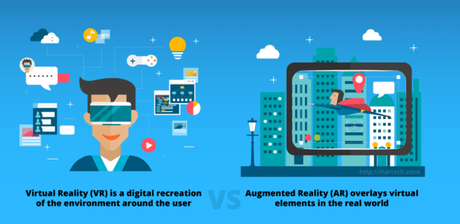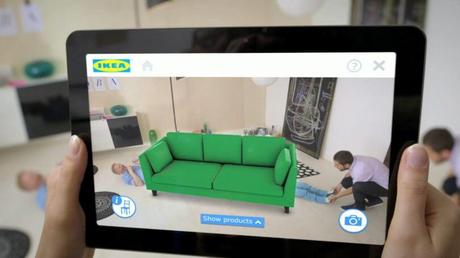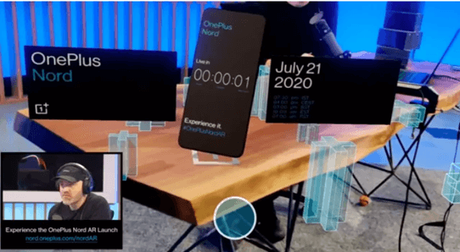We are living in a 3-dimensional world coping with 2-dimensional technology. Even though it has been very helpful we are still making decisions and process our actions in the 2D app screens and webpages.
Augmented reality is that one promising technology that is acting as a bridge to exploring unique human capabilities. Augmented reality proved its mettle long back through the infamous Pokémon Go app in 2016 where Pokémon characters were superimposed in outdoor environments.
A year later Apple launched its ARKit platform and Google gave away API prototypes for free. With its increasing popularity and support from tech titans through huge investments, now we have Microsoft HoloLens, the rumored Apple AR glasses, and many other technological advancements that are making their way to our everyday lives.
AR is set to become the new interface between the digital and physical worlds. Tech giants such as Amazon, Facebook, General Electric, Mayo Clinic, are already implementing AR and are seeing growth in experience, quality, and productivity.
In this article, we shall delve into the various solutions and examples of how companies can deploy augmented reality in their business strategies.
What Is Augmented Reality?Augmented reality (AR) is an interactive experience of a real-world environment where the objects that reside in the real world are enhanced by computer-generated perceptual information, sometimes across multiple sensory modalities.
As the name suggests, it's a technology that enhances reality by superimposing digital data and images in real-world environments. Today, AR experiences are popular on smartphones which helps in viewing the augmented world. There are many AR entertainment applications such as Snapchat filters, Pokémon Go, and other futuristic video games.
Augmented reality can be operated through mobile phones, screens, head-mount displays and very soon shift to hands-free augmented reality smart glasses.
Though augmented reality provides immersive experiences, they are fully immersive like virtual reality(VR).
How Is Augmented Reality Different From Virtual Reality?

While augmented reality displays images through cameras or smartphones, virtual reality needs specialized VR headsets such as HTC Vive, Oculus Rift, or Google Cardboard. Users can be transported into several real-world and imagined environments through Virtual reality.
I regard [AR] as a big idea, like the smartphone. The smartphone is for everyone, we don't have to think the iPhone is about a certain demographic, or country or vertical market: it's for everyone. I think AR is that big, it's huge. I get excited because of the things that could be done that could improve a lot of lives. - Tim Cook
Use Cases Of Augmented Reality In Various Industries
Augmented reality apart from being an entertainment tool is now being used in myriad ways in both consumer-centric and B2B-based setups. By 2021, every industry has found a way to sideline traditional methods to improve productivity and outcomes. Some of the common use cases include:
Augmented reality in Ecommerce
AR has been helping millions of consumers make informed decisions before buying products on eCommerce apps . They can now preview products or experience services in their desired environment.
, an online buy and sell marketplace, is now using the power of augmented reality to sell over five million items in the Art and Collectibles. iOS app users can now bring any piece of wall art on Etsy to life and visualize its size, look and vibe in their homes or workspaces.
IKEA, one of the initial companies that dared to use AR in their app, now offers libraries with thousands of 3-D augmented reality furniture and apps that integrate them into a view of an actual room, enabling customers to see how furniture and decor will look in their homes.

Enhancing Print And Marketing Through Augmented Reality- AR Image Recognition & Tracking
AR is now on a mission to revive and enhance print and 2-D communication and replace them with interactive content.
From direct mail to flyers, postcards, posters, magazines, educational books, and everything in between, you can apply augmented reality to almost every type of print medium.
Wonderwest , a fashion brand, used AR postcards to engage and increase sales within their existing customer base for their new Autumn product line. They used an innovative Direct Mail campaign using postcards that come to life through augmented reality.
Users could avail of the promotional discount offer by scanning the postcard via their smartphone cameras which opens to a WebAR solution without any app. With Image tracking enabled, the 2D video mirrors the perspective of postcards.
They could add value through custom Call-to-Action buttons that drive users to the Boot Barn e-commerce website. With a 39.25% click-through rate, they could increase the sales of the 'Wonderwest' product line.
Augmented Reality In Retail Stores- AR Navigation
With the help of Beacons or visual markers, also known as AR Markers an image can be recognized using the apps built on Apple's ARKit and Google's ARCore. This helps in positioning, mapping, and rendering accurate directions in large and low-rise buildings, such as airports or retail stores . This is known as AR navigation.
uses the beacons for its in-store mapping feature in the Target app, as well as to display nearby deals to shoppers. The map also shows aisles that indicate where products are in the store. Consumers can tap on a product in the app and see on the map both where the item is and where they are standing in relation to it.
AR Filters Boost Social Media Marketing
Before the success of the Pokémon game, Snapchat already had AR-based Snap Filters that could track and change a user's face with quirky additions such as dog ears, baby eyes, glasses & even full-face make-up.
Instagram and Facebook launched their Spark AR studio in 2019, letting anyone create and share their own filters. These exploded filter trends not only engage and entertain, but also helps brands to communicate with their customers using powerful messages.

Brands like and Pepsi have used AR filters for the promotion of their marketing campaigns.
Make-up filters, gamified AR filters, Brand-based photo frames, and fashion and lifestyle-based filters are popular among social media apps .
Transforming Events Through Augmented Reality- AR Live Streaming
Event planning struck a new chord when AR came into the picture. According to a , 88% of the event creators used augmented reality events in 2018.
Event planning of automobile giants like Mercedes, Art exhibits, press conferences, and even bands are turning towards AR live streaming events.

Recently in the COVID lockdown, OnePlus, the infamous smartphone manufacturer, unveiled its Nord series in the world's first-ever augmented reality smartphone launch through its OnePlus Nord AR app.
Read More: Latest Augmented Reality Trends!Future Of Augmented Reality In Business
With the above-mentioned use cases in various industries, the most relevant and necessary application of augmented reality is in the commercial retail sector. This sector is in need of new brand selling capabilities as there is a decline in foot traffic and restrictions in stores.
By introducing AR features in their existing apps and websites they can enhance their customer experiences. With the merger of real and virtual experiences with quality 3D visualizations, companies can achieve in-store shopping at the ease of the user's home.
Believe it or not, the statistics also agree to this notion as,
Explore the world of AR. Tap into a window of new opportunities.
All the augmented reality technology at the end of the day is customized, enhanced, and marketed with one goal to improve our ability to rapidly and accurately absorb information, make decisions, and execute required tasks quickly and efficiently.

